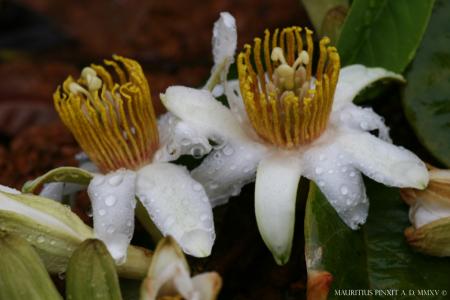
SUBGENUS: astrophea
SUPERSECTION: pseudoastrophea
SECTION: pseudoastrophea
GEOGRAPHICAL DISTRIBUTION OR ORIGIN:
Brazilian Amazon. Guyane.
MINIMUM TEMPERATURE: 15 °C
IDEAL MINIMUM TEMPERATURE: 20 °C
ETYMOLOGY: From the Latin candidus, pure white, characteristic of the corolla.
DESCRIPTION:
This little-known species has not yet been sufficiently studied to predict its behaviour outside its natural habitat: the forests of French Guiana and the Amazonian area of Brazil. However, we already know that it is a demanding plant and that it can only be grown in a warm greenhouse. It has a shrubby/arboreal appearance (typical of the passionflowers belonging to the subgenus Astrophea), a robust structure and leathery leaves. The flowers are also significant, due to their pure white corolla and erect corona with golden filaments.
The whole leaves are very wide in the centre, have an ovate shape, and a sharp base and tip. The ribs are very evident against a shiny blade. The maximum dimensions are 18 cm in length and 14 cm in width.
The flowers (7 cm in diameter), usually erect, have sepals and petals folded elegantly downwards, while the corona rises above them, opening upwards in an inverted cone. The rigid filaments, slightly wavy, are coloured a deep yellow with orange veins, bringing to mind the colour of gold, as if in homage to a gold-bearing land.
The fruit is ovoid and measures about 6 cm in diameter.
There is still no information on how it behaves in the
greenhouse, and only a few years ago a number of European collectors owned
small specimens. My experience suggests to me that flowering may only occur on
very large plants, which will be difficult to achieve in small family
greenhouses. A 20 cm high rooted cutting enriched my collection years ago. I
tried to study and acclimatise this beautiful but difficult plant – checking
its resistance to cold, discovering its needs – but unfortunately, it died
quickly.